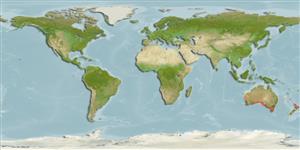Environment: milieu / climate zone / depth range / distribution range
นิเวศวิทยา
เกี่ยวกับทะเล,น้ำเค็ม เกี่ยวกับหินโสโครก; ระดับความลึก 1 - 70 m (Ref. 9563). Temperate
Indo-Pacific: Southern Australia from central New South Wales to a similar latitude in Western Australia.
ขนาด / น้ำหนัก / Age
Maturity: Lm ? range ? - ? cm
Max length : 40.0 cm TL เพศผู้/กระเทย; (Ref. 9563)
Found commonly in shallow bays. Nocturnal. Occurs in small aggregations.
Life cycle and mating behavior
วัยเจริญพันธุ์ | การสืบพันธุ์ | การวางไข่ | เซลสืบพันธ์ของเพศเมีย(ไข่) | ความดกของไข่ | ตัวอ่อน
Kuiter, R.H., 1993. Coastal fishes of south-eastern Australia. University of Hawaii Press. Honolulu, Hawaii. 437 p. (Ref. 9002)
IUCN Red List Status (Ref. 130435: Version 2024-1)
Threat to humans
Poisonous to eat
Human uses
การประมง: ไม่มีผลประโยชน์
เครื่องมือ
Special reports
Download XML
แหล่งที่มาจากอินเตอร์เน็ต
Estimates based on models
Preferred temperature (Ref.
123201): 15.1 - 22.4, mean 17.8 °C (based on 198 cells).
Phylogenetic diversity index (Ref.
82804): PD
50 = 0.5313 [Uniqueness, from 0.5 = low to 2.0 = high].
Bayesian length-weight: a=0.04677 (0.01905 - 0.11483), b=2.82 (2.61 - 3.03), in cm total length, based on LWR estimates for this (Sub)family-body shape (Ref.
93245).
ระดับชั้นอาหาร (Ref.
69278): 3.8 ±0.2 se; based on size and trophs of closest relatives
ความสามารถในการกลับคืนสู่ปกติ (Ref.
120179): ขนาดกลาง, เวลาต่ำสุดที่จะทำให้ประชากรเพิ่มขึ้นเป็น 2 เท่าใช้เวลา 1.4 - 4.4 ปี (Preliminary K or Fecundity.).
Fishing Vulnerability (Ref.
59153): Low to moderate vulnerability (30 of 100).
Nutrients (Ref.
124155): Calcium = 12.6 [4.6, 33.8] mg/100g; Iron = 0.208 [0.097, 0.509] mg/100g; Protein = 18.7 [16.5, 20.9] %; Omega3 = 0.306 [0.149, 0.623] g/100g; Selenium = 9.16 [3.91, 21.99] μg/100g; VitaminA = 31 [7, 149] μg/100g; Zinc = 0.47 [0.30, 0.77] mg/100g (wet weight);
